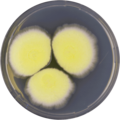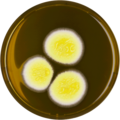| Aspergillus neoafricanus | |
|---|---|
| Scientific classification | |
| Kingdom: | Fungi |
| Division: | Ascomycota |
| Class: | Eurotiomycetes |
| Order: | Eurotiales |
| Family: | Aspergillaceae |
| Genus: | Aspergillus |
| Species: | A. neoafricanus |
| Binomial name | |
| Aspergillus neoafricanus Samson, S.W. Peterson, Frisvad & Varga (2011) [1] | |
Aspergillus neoafricanus is a species of fungus in the genus Aspergillus . It is from the Terrei section. [1] The species was first described in 2011. [1] It has been isolated from soil in Ghana, Panama, and Japan. [1] It has been reported to produce aspulvinone, asterriquinone, butyrolactones, citreoviridin, mevinolin, terrain, and terrequinone A. [1]

